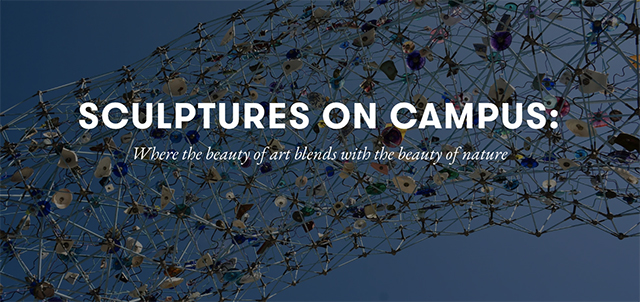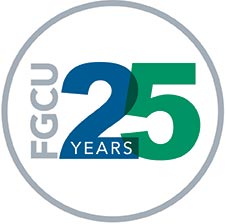
Shortly after entering the main entrance at Florida Gulf Coast University, visitors happen upon one of its most iconic works of art: “Human Race.” The two-story steel sculpture stands proud in front of the Lutgert College of Business; it was the creation of philanthropist Raymond L. Lutgert, for whom the building and college are named.
Wander the campus and you might discover a colorful three-dimensional snake with an apple and a mischievous smile by Brazilian artist Romero Britto, an abstract tropical-themed metal sculpture by world-renowned artist Albert Paley and etched porcelain tiles resembling water in motion by Lucas J. Century.
In celebration of the university’s 25th anniversary, a digital tour has been created of these and other notable public artworks on campus, through which visitors can learn about the history behind each piece.
They are installed in spaces that are open to all. “We are always looking for ways to deepen and enrich the community’s experience,” said John Loscuito, FGCU art gallery director. “The public art installations bring people in the Southwest Florida region to campus, providing access to become more familiar with their property, their community.”
It can be something of a treasure hunt for art lovers to discover these works, many of which are part of the Florida Art in State Buildings program, which incorporates large-scale artworks into the campus environment. The sculptures can be found inside campus buildings, suspended from lobby atriums and outside, as focal points between buildings.
 Each unique artwork has been acquired either through the state program – which earmarks one-half of 1% of the amount the Florida Legislature appropriates for the construction of state buildings for acquisition of public artworks — gifted by donors or by the artists themselves.
Each unique artwork has been acquired either through the state program – which earmarks one-half of 1% of the amount the Florida Legislature appropriates for the construction of state buildings for acquisition of public artworks — gifted by donors or by the artists themselves.
According to local art historian Tom Hall, “the function of art in public places is to stimulate thought, conversation and activity. Public art humanizes the built environment. Public art matters because our communities gain cultural, social and economic value through public art.”
Over the years the collection has grown with the pace of building and growth on campus. In addition, the university has an array of two-dimensional pieces on display throughout each of the four floors of the Bradshaw Library, and is host to a collection of donated art.
